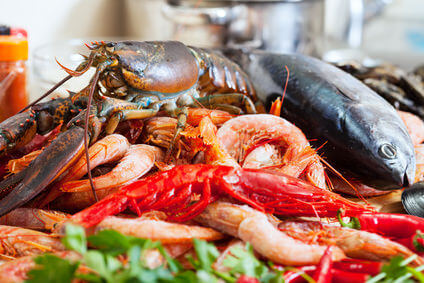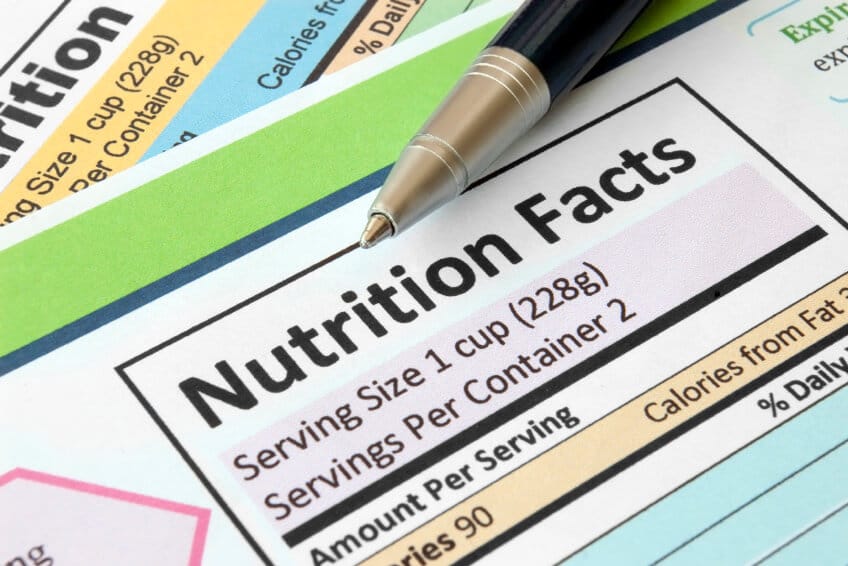Food allergies are an increasing common problem, particularly among children. In fact, the CDC has estimated that the rate of food allergies among children increased by 50% between the years 1997 and 2011. This makes it imperative that anyone caring for a child with food allergies should know the basics of prevention and management.
While many people experience various reactions to different types of food, it is important to distinguish between food allergies and food sensitivities. The latter is far less serious than the former and simply involves having intolerances to certain foods. The main reason why these two conditions are often confused is that they share signs and symptoms.
As the Mayo Clinic points out, a true food allergy involves a reaction from the immune system which can affect multiple organs in the body and produce a wide range of different symptoms, even going as far, in some extreme cases, as being life-threatening. (1)
When someone experiences a genuine food allergy, even the tiniest amount can be enough to trigger a reaction. Common symptoms include nausea, vomiting, diarrhea, cramps, hives, swelling of the face, and a tingling sensation in the mouth. When the allergy is severe and dangerous, this condition is known as anaphylaxis and it comes with symptoms such as low blood pressure and difficulty breathing.
Food sensitivities, on the other hand, do not directly engage the immune system, and the reaction is far more gradual. It is possible for people with food intolerances to consume small amounts of the offending food without experiencing any symptoms at all. However, in the longer term food sensitivities can have a serious impact on our general health. When looking at chronic conditions like adrenal exhaustion, chronic fatigue syndrome, fibromyalgia and more, ruling out food sensitivities is a good first step to take.
Here are the sections in this article:
Section 1: The 8 Most Common Food Allergens
Section 2: How To Prevent An Allergic Reaction
Section 3: How To Manage A Severe Allergic Reaction
Section One: The 8 Most Common Food Allergens
Individuals can be allergic to a wide variety of different foods, but an overwhelming majority of these allergies are in response to a small number of foods. In fact, around 90% of food allergies concern 8 specific allergens: peanuts, milk, eggs, wheat, nuts, soy, shellfish, and fish.
1. Peanuts

Peanuts are among the most common allergens, and are also among the most dangerous. They can trigger a dangerous anaphylaxis reaction that can be potentially fatal. Peanut allergies increasing in frequency, and in fact the number of children who suffer from a peanut allergy has more than tripled in the U.S. over the last 15 years. Studies show similarly increasing numbers in the UK and Canada. Since peanuts are a common ingredient in many types of foods, sufferers from peanut allergies are strongly recommended to carry auto-injectors with epinephrine with them at all times in order to prevent a reaction (the EpiPen is the most well-known example).
Research into peanut allergies is ongoing . There are many facts that are still unknown, but current studies suggest that the majority of peanut allergy cases last for the entire life of the sufferer. On a more positive note, it has been reported that around a fifth of children with peanut allergies eventually outgrow the condition. It is also likely that there is a genetic predisposition towards peanut allergies. The younger siblings of children with peanut allergy have a higher chance of also developing this problem themselves.
Despite its name, the peanut is not a nut like walnuts, almonds, cashews etc., but is rather a legume. You may also be surprised to hear that it grows underground, while normal nuts grow on trees. The relevance of this is that a person allergic to nuts will not necessarily be allergic to peanuts, although studies suggest that around 25 – 40% of peanut allergy sufferers are also allergic to tree nuts.
2. Tree Nuts

Like a peanut allergy, tree nut allergies can also trigger dangerous, life-threatening reactions that may require the sufferer to carry an EpiPen or other kind of auto-injector. It is also a condition which can be passed on genetically, and it seems to be more persistent than a peanut allergy. Only around 9% of children who suffer from tree nut allergies eventually outgrow their condition.
There are many kinds of tree nuts that can be allergens, such as hazelnuts, cashews, walnuts, almonds, pistachio nuts, and more. A person does not have to be allergic to all of them, and it is entirely possible that they will be allergic to a specific kind of tree nut. However, the chance of an individual with a tree nut allergy also being allergic to another kind of tree nut, is much higher than that of someone with no other allergies. Furthermore, there is a high chance of cross-contact between different types of nuts during the manufacturing processes of many products. This is why those with individual tree nut allergies are usually advised to avoid tree nuts altogether.
3. Milk

For small children and infants, milk is the most common allergen. When talking about milk, most people will refer to cow’s milk since that is the most widely used. Milk also causes the most confusion between food allergy and food intolerance, as lactose intolerance is the most common type of food sensitivity. A milk allergy can be much less severe than that of a nut allergy, presenting itself only with hives, itchiness, nausea etc. However, there can also be severe cases of anaphylaxis, so standard safety procedures are still recommended.
Since milk allergies are such a big problem for infants, it is often necessary to feed them a different kind of formula if they are bottle-fed. These hydrolyzed, casein-based formulas are still nutritious, but the protein differs from milk protein enough not to cause any kind of allergic reactions. The good news is that most children will outgrow their milk allergy, with only a small percentage actually living with it their entire lives.
Milk is used in many foods, which is why the FDA requires it to be mentioned on the label just like nuts and peanuts. While it is pretty obvious that milk is used in dairy products and baked goods, there are also many unexpected sources of milk. For example, many types of meats are prepared using butter, and the meat slicers at deli counters are also used for cutting cheese, so a person with a milk allergy must really be careful what they eat.
4. Eggs

As with milk, eggs represent a very common allergen for children. Again, there is a wide range in terms of possible symptoms. Individuals with a mild allergy to eggs will only experience hives and rashes, while the most severe cases may go into anaphylactic shock. An egg allergy is uncommon in adults, as most children who are allergic to eggs thankfully outgrow the condition.
Strictly speaking, the egg white is the allergen in almost all cases of egg allergies. However, sufferers are required to avoid eggs altogether because it is almost impossible to completely separate the egg white and the yolk. In some cases, even the smallest amount can trigger a reaction.
Individuals with egg allergies need to be careful what they consume because eggs are a main ingredient in various types of foods. This is particularly true for snacks and baked goods. All packaged products are required by the FDA to warn on the label if they contain eggs, so that people with allergies can avoid them. One unexpected potential source of eggs is a flu shot. According to the CDC, the standard influenza vaccine is manufactured using viruses grown in eggs. (2) This means that trace amounts of eggs might still be detected in vaccines. There are alternatives available, but the doctor must be made aware of any such allergies.
5. Wheat

Wheat is a very common allergen that is mostly a problem for children. The majority of small children with a wheat allergy will outgrow it by the age of three. The symptoms presented in the case of a wheat allergy will vary based on the severity of the condition: it can be something mild with symptoms such as rashes, itchiness, soreness, and hives, or it can be something more serious such as anaphylaxis.
It can be quite difficult to avoid a widely used grain like wheat, as it is very common in the average Western diet. An individual who has a wheat allergy can still consume all of the major food groups, but they have to make sure that the grain source is something else such as corn, oats, rice or barley. Wheat will often appear in products that you would not expect to contain it, so it is imperative that sufferers read their food labels carefully. Common examples of foods that contain wheat are beer, potato chips, hot dogs, ice cream, and more.
A genuine wheat allergy should not be confused with celiac disease or an intolerance to gluten. In fact, there is a clear distinction between the three. (3) A gluten intolerance simply means that the body has problems digesting this food source, and celiac disease is a condition where gluten triggers an abnormal immune reaction that affects the small intestine.
6. Soy

A soy allergy is very similar to a wheat allergy, in that it also tends to affect infants and small children and it is outgrown early in life. A typical allergic reaction to soy is milder than other allergies and only presents symptoms such as an upset stomach and hives. Severe cases of anaphylaxis are very rare, but they can occur.
Soybeans are part of the legume family, which is characterized by seed pods that split when they ripen. This family also includes peanuts and other foods such as beans, peas and lentils. However, having an allergy to soy does not increase the chances of any other kind of allergic reaction, even to peanuts.
On its own, soy is not commonly used for food preparation, but it is part of many processed foods. Soy allergy sufferers need to carefully check their food labels. Soy is often a substitute used by vegans and vegetarians for meat and other products, so a person with a soy allergy will find it a lot harder to stick to a vegetarian diet.
7. Fish

Unlike other common allergies, a fish allergy is more common in adults than it is in children. This allergy will typically last for an entire lifetime. A fish allergy can exhibit all of the common allergy symptoms, including anaphylaxis in the most severe cases. Fish is a very broad term that is comprised of many different kinds of animals, and people are not necessarily allergic to more than a single kind of fish. However, the chances of a fish allergy sufferer also being allergic to other kinds of fish are much higher than for people with no allergies, and that is why it is advised that these people stay away from fish altogether. Halibut, salmon and tuna are the most common allergens.
Allergy sufferers need to be careful, as fish can be an ingredient in many other kinds of food. This applies particularly to various sauces and dressings such as barbecue sauce, Worcestershire sauce, and Caesar dressing. Because of the name, many people think that an allergy to fish also includes shellfish and vice-versa, but the two are actually unrelated. There is no correlation between having a fish allergy and a shellfish allergy.
8. Shellfish

A shellfish allergy can cause a wide range of symptoms, including breathing troubles, dizziness, low blood pressure, and life-threatening anaphylaxis. This allergy usually develops later on in life, during adulthood, and when it develops it typically becomes a lifelong condition.
Shellfish are not related to normal, finned fish in any way, so a person allergic to one will not necessarily be allergic to the other. Instead, an individual allergic to shellfish usually experiences allergic reactions to lobster, crab, and shrimp, among others. These are all crustaceans and represent the most common allergens. There is another group of shellfish, mollusks such as muscles, clams, and scallops, which represent much less common allergies. Crustacean shellfish allergies are not just more common, but they also tend to be more serious. Medical professionals advise a person with any kind of shellfish allergy to avoid all other types of shellfish.
Most seafood is either fish or shellfish so a person who enjoys this kind of diet must be careful what they eat. Allergy sufferers may not always be familiar with less common types of shellfish, like cockles, abalone, sea cucumber, cuttlefish, snails, and more. For these people, it is best to avoid seafood altogether.
Section Two: How To Prevent An Allergic Reaction
Approximately one in 13 children suffers from a food allergy. According to a 2013 study released by the Centers for Disease Control, the rate of food allergies among children increased by 50% between the years 1997 and 2011. (4) Allergic reactions to food can be life-threatening. It is imperative that parents of allergic children know how to adequately prevent allergic reactions and, should it reaction occur, how to manage them.
Because there is no cure for food allergies, prevention is the number one line of defense for parents of allergic children. The following guidelines can help to prevent children from suffering allergic reactions to food both in the home and on the go.
Prevention In The Home

1. Know what your child is eating and drinking
Knowledge is the number one element of prevention. It is imperative that the parents of children with food allergies read food labels thoroughly. Parents should avoid relying on pictures or product descriptions on the packaging. Even foods that are labeled “all natural” can frequently contain hidden or unlisted ingredients.
For example, many fruit juices are actually a blend of the main listed fruit and other juices like grape or pear juice. A parent may see a label for a cherry juice that says, “100% natural flavors”. The parent may not realize that those natural flavors may include more than just cherry juice. If the child is allergic to grapes, feeding them this cherry juice may cause an unexpected and unintended allergic reaction.
Additionally, most packaging will disclose whether the product is produced on shared or dedicated equipment. Shared equipment means that both allergenic and non-allergenic products are made using the same equipment. Although the product itself may be free of a particular allergen, it may still contain trace amounts of that allergen if shared equipment is used. Tools and equipment that are used solely for non-allergic ingredients are known as ‘dedicated equipment’ (sometimes seen as ‘dedicated facilities’). Thanks in part to the recent explosion of food allergies among children and adults, there are many more dedicated facilities and allergen-free food products available than ever before.
When in doubt as to what certain food terms or labels mean, parents are well advised to spend some time researching on the Internet. For example, Carnauba wax is a popular ingredient in candy. Parents of children allergic to bees may wonder if this was is somehow related. A quick search clarifies it is derived from Palm trees. After checking online resources, parents should then follow up on any questions they may still have with their child’s allergist or healthcare provider.
2. Prevent cross contamination in the kitchen
Most households have a mixture of members with and without food allergies. Even in households where more than one member is allergic, those allergies may be entirely different. As a result, there will generally be both allergic and non-allergic foods and products in the kitchen. Avoiding cross-contamination of various foods will prevent those suffering from allergies from having a reaction.
The first step to preventing cross contamination in the home is to label all foods as safe or unsafe. Parents can physically write “safe” or “unsafe” on each item using a permanent marker. They can also use a sticker system, say red dots on unsafe foods and green dots on safe foods, but be aware that refrigerated and frozen foods can develop moisture and cause the stickers to detach. To be absolutely certain, make it a rule that no one consume or serve unmarked foods without first checking with a parent.
After labeling food, the next step is to physically separate the safe from the unsafe products. Designate shelves in the refrigerator, cabinets and pantry for safe foods only. This reduces the chance that someone will use an unsafe food by mistake, even if the labels are damaged or missing.

When it comes to food preparation, have a separate set of safe utensils and tools, especially those for food preparation. Examples are cutting boards, mixing bowls, serving spoons and dishes. Pots and pans can be scrubbed with hot water and soap after use so it is usually not necessary to obtain a second set. If a family cannot afford or store two sets of utensils and tools, make sure to thoroughly wash these items with hot water and soap after use.
When cooking for a family of allergic and non-allergic individuals, always prepare the safe foods first. This further ensures that allergy sufferers are not accidentally exposed to items that can make them sick.
Prevention On The Go
1. Exercise caution at restaurants
At restaurants, parents should alert the wait staff that the child has allergies to certain foods, and strongly emphasize the point. It is important that they know these dietary restrictions are not a “lifestyle choice” but rather a medical necessity that could be life-threatening if not observed. Parents should also ask about food preparation and make sure that the food to which the child is allergic is not prepared on the same surfaces or using the same utensils as other foods. If parents cannot fully ensure the suitability of a particular restaurant, they should bring safe foods or snacks from home for the child to consume. Better to be safe than sorry.
2. Notify others of the food allergy
Get a medical alert bracelet or necklace for the child, and ensure they wear it. They are customizable and list the offending foods and instructions on how to provide aid. Modern versions are available in multiple patterns, bright colors and Velcro closures.
Make sure to inform school officials, teachers, caregivers and relatives of the food allergy. Emphasize the seriousness of the situation. Hundreds of allergic reactions occur every year when well-meaning adults attempt to “include” allergic children with group foods or snacks.
Create an action plan so that caregivers and others know how to recognize and respond to an allergic reaction. Include any medications obtained from the allergist or healthcare provider, especially an epinephrine auto injector like EpiPen, Twinject, or Auvi-Q.
Section Three: How To Manage A Severe Allergic Reaction
Allergic reactions can manifest anywhere from a few minutes to hours after the offending foods are ingested. Symptoms can range from hives, rash, or runny nose to upset stomach, or a more serious condition called anaphylaxis. Teenagers and young adults with food allergies are at the highest risk of fatal food-induced anaphylaxis. (4) This rapidly progressing, life threatening allergic reaction can affect several body systems. Symptoms include hives, swelling of the tongue, mouth and/or sinuses, respiratory difficulty, low blood pressure, rapid heartbeat, and loss of consciousness. (5) Allergic reactions that start out with mild symptoms like itchiness or rashes can progress to anaphylaxis if left untreated. Additionally, a child will not always react to the same allergen the same way. In other words, even if they had a relatively mild reaction to a certain food once, they can have a more severe reaction to the same food the next time.
If prevention has failed and a child accidentally consumes a food that causes a reaction, take immediate action. Once a child has been diagnosed with food allergies, parents should consult their allergist or healthcare provider for how to manage allergic reactions. The following instructions were obtained from a particular allergist, they are meant to be a general guideline and not to supersede the advice of any other healthcare professional.
If the reaction appears mild, administer an antihistamine like Benadryl. Parents need to consult a healthcare provider about the proper dosage before an emergency strikes. After administering the antihistamine, continue to monitor the child. If symptoms do not improve or appear to be getting worse, it may be time to administer the epinephrine auto injector. Again, parents should clarify when and how to use the injector before an emergency strikes. Most auto injectors come with training injectors so that parents and caregivers can practice how to use the device and learn where on the body to administer it. It is best to take advantage of these training injectors and practice before they are ever needed.

After an auto injector is used, it is imperative to follow up with emergency care. Call 911 or take the child to the emergency room. This is required because an anaphylactic reaction can sometimes require more than one dose of epinephrine to fully resolve. Additionally, sometimes an anaphylactic reaction can flare up a second time and thus require more treatment.
Parents must be sure that anyone who cares for or supervises a child with food allergies is well aware of the allergy and the signs and symptoms of a reaction. This is why a medical alert bracelet or necklace is essential.
Parents should also ensure that medications used to treat allergic reactions are readily available. Have a supply in the home, in the family car, and provide medications to school officials and other caregivers, including relatives and friends. Older children can be given medicines to keep on their person. Finally, parents also need to make sure that caregivers are trained in the proper administration of medicines, including the epinephrine auto injector, and on the importance of follow up care including emergency services.
References & Further Reading
1. Mayo Clinic, “What’s the difference between a food intolerance and food allergy?”, http://www.mayoclinic.org/diseases-conditions/food-allergy/expert-answers/food-allergy/faq-20058538.
2. CDC, “Seasonal Flu Shot”, http://www.cdc.gov/flu/about/qa/flushot.htm.
3. Food Allergy Research & Education, “Wheat Allergy”, http://www.foodallergy.org/allergens/wheat-allergy.
4. FoodAllergy.org, “Facts and Statistics”, http://www.foodallergy.org/facts-and-stats.
5. Mayo Clinic, “Anaphylaxis”, http://www.mayoclinic.org/diseases-conditions/anaphylaxis/basics/definition/con-20014324.
6. An example of how child care programs can cope with food allergies. http://www.appleton-child-care.com/child-care-nutrition.shtml.



